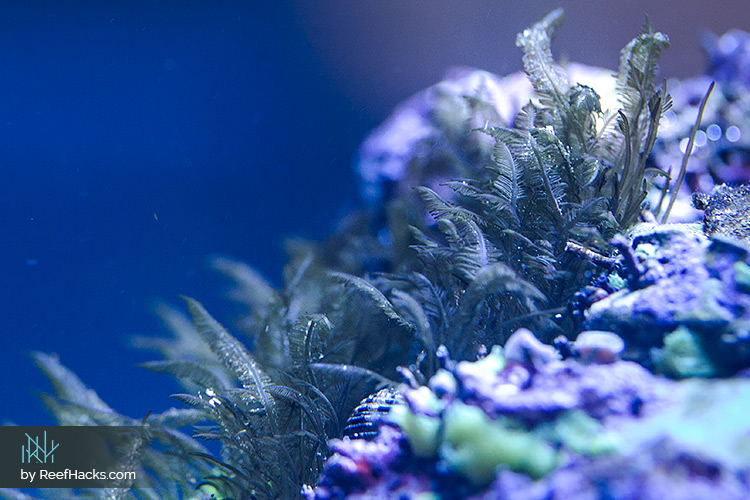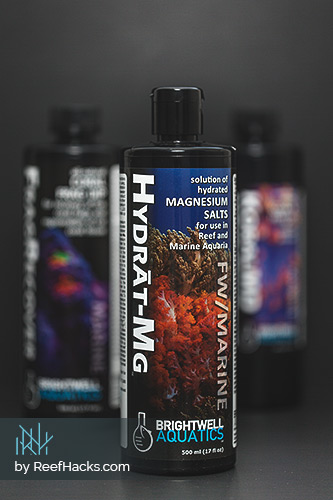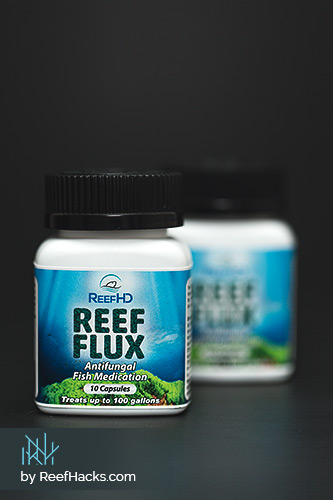Aliens! They do exist!
Don’t worry, this isn’t an elaborate post filled with conspiracy theories and “true life” stories of my best friend’s uncle’s mechanic who once saw little green men in his driveway. While entertaining, I’ll leave those stories to professional theorists and science fiction writers.
Although the existence of life beyond our world is debatable, as far as your reef tank’s concerned, tiny green invaders capable of mass destruction is a very real threat. Silently, these unwelcome guests infiltrate its underwater world. Within a matter of days, what began as a small curiosity blooms into an outright conquering.
So, who are these aliens, and more importantly, do they come in peace?

Author:
As a lifelong aquarist, Yuliya has an endless curiosity about our underwater universe. After graduating with a bachelor’s in Environmental Engineering, she transformed her passion into a successful career. While working at the Institute of Environmental Protection in Moscow, her passion for saltwater and reef aquariums only increased. Moving to the United States in 2013, Yuliya embarked on another impactful journey by sharing her unprecedented experience for all aquarium hobbyists ... Read More.
I’m discussing none other than Bryopsis algae. Classified as a macroalgae, B. pennata and B. plumosa, as its formally called, is notoriously difficult to properly identify and eradicate.
Much like a Hollywood movie, once an invasion begins, removal requires a combination of creative thinking, scientific understanding and an epic soundtrack (optional).
While this alien species tends to avoid midnight abductions, and unsavory probing, in order to kill it, you must first understand its strengths and weaknesses.
Unraveling the Tangled Realm of Algae - What is Bryopsis Algae?
At first glance, Bryopsis looks like small patches of underwater grass. In reef tanks, the onset of an outbreak starts small. In most cases, you’ll notice thin hair-like strands attached to live rocks or coral. Eventually, these sporadic strands proliferate into dense patches.
Officially classified as a photosynthetic organism in the bryopsidaceae algae family, Bryopsis proliferation is often triggered by water chemistry and light exposure. If you’re wondering what causes Bryopsis, you’re not alone. However, before diving into the cause of this frustrating situation, are you sure the algae overtaking your tank is, in fact, Bryopsis?
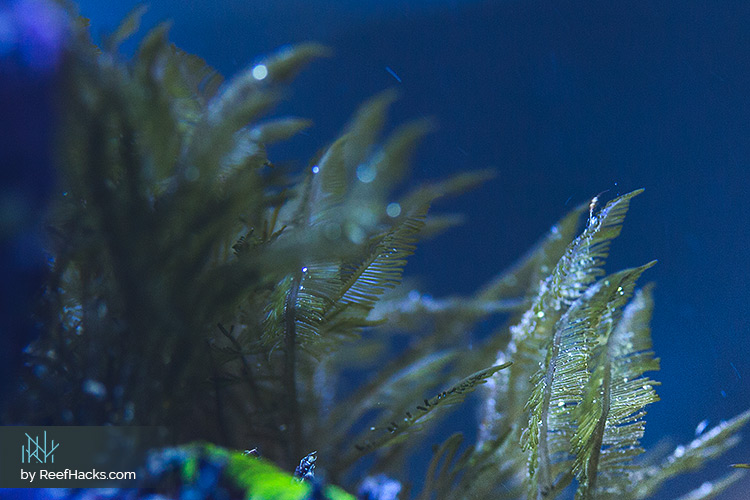
The Strands of Illusion - How To Identify Bryopsis.
Unless you’ve studied marine life, identifying Bryopsis algae isn’t as easy as you may think. Sure, noticing an algae bloom is easy. Simply look for growing patches of what appears to be grass. However, just because it looks like Bryopsis, doesn’t mean it is.
More times than not, Bryopsis is mistaken for GHA, or green hair algae. While initially similar, there’s several distinct differences between Bryopsis and hair algae. The most noticeable difference is its size. Bryopsis algae tends to be larger, both horizontally and vertically, than GHA, which often features shorter reach.
Next, look at the algae root structure.
Bryopsis algae roots itself deep into the surface of rocks or coral and forms a complex covering, which looks like a dense welcome mat. This provides Bryopsis with a sturdy grip to whatever surface it attaches to.
GHA, on the other hand, generally doesn’t have an easily identified root structure. It’s easily moved off rocks and can also grow in aquarium sand.
The branches of Bryopsis are distinct in comparison to any other green hair algae species. Essentially, the tiny hair-like strands resemble common variety ferns and feature dense trunks. GHA strands are smoother and have less-distinct physical characteristics.
Lastly, if you’re still unsure of algae type, turn to your tank inhabitants. The majority of creatures that enjoy an algae meal shy away from consuming Bryopsis. However, most members of your aquarium cleanup crew eat GHA without hesitation.
The Sneaky Life of Bryopsis Algae - Causes of an Infestation.
Although there’s many circumstances responsible for introducing this nuisance algae into your tank, let’s briefly explore the two most common causes of Bryopsis algae:
- Live Rocks - Considered an essential component for any reef tank, live rocks may boost tank viability, but it’s not without risk. Even the most cautious of aquarists can accidentally introduce Bryopsis into their tank via live rocks. Algae can attach itself to the surface of live rocks, and unbeknownst to the hobbyist, overtake an aquarium. This is why I always recommend to use dry live rocks. Read more ...
- Frag Plugs - Another common cause of Bryopsis infestations occurs when frag plugs are placed into a tank with your new corals.
The rate of growth depends on a variety of factors. Everything from light concentration to water chemistry either influences or hinders Bryopsis growth. However, a swiftly developing algae bloom is typically an indicator of higher-than-desirable phosphates and nitrates.
Here’s where the trickery of alien invasions comes into play. Even before massive patches overtake rocks, elevated nitrates and phosphate levels generally aren’t detectable with standard tests. As the Bryopsis population sneakily expands, its consumption of nitrates and phosphates gives the illusion of proper water chemistry.
Much like the plot of a B-movie, where bodysnatching aliens secretly infiltrate a civilization, Bryopsis attempts to hide until its population grows in size and number. By this point, removing this invasive algae is far more difficult.
The Frantic Expanse of Domination - Reproduction and Life Cycle.
As an asexual organism, Bryopsis algae accelerates its reproduction through fragmentation. Essentially, this means an entire colony self-replicates by releasing cells out into the water.
Ever wondered how an unnoticeable concentration of algae on a live rock can result in complete tank domination? This is why.
While asexual reproduction occurs naturally, you can actually expedite its spread. For example, after noticing its green strands reaching out into the watery expanse, you swiftly reach in and yank what you can off your precious rocks.
Although your intentions are good, you single handedly (literally) helped Bryopsis spread throughout your tank. Even though it may look as if you removed all of the algae, small bits flaked off during the traumatic uprooting.
Since only a few cells are all that’s needed to repopulate this invasive species, you may have won the battle, but the war is far from over.
As a general rule, fight the urge to pluck Bryopsis. So, how do you kill Bryopsis? One word: sneakily.
The Definitive Combat Plan - How To Remove Bryopsis Algae.
There’s a reason why reef tank hobbyists loathe this algae more than almost any other invasive organism. No, it’s not because we have an unnatural repulsion for anything green and wavy. The root of our disdain is because Bryopsis is a serious pain to remove.
Just when you think you’ve finally killed the last survivors, boom, it reappears. Mounted against your favorite coral or rock, its stringy branches tauntingly wave hello as you throw your hands up in defeat.
But, there’s hope. Just because it’s difficult to kill doesn’t mean it’s impossible.
Will Anything Eat Bryopsis?
Unlike many other invasive plant organisms, Bryopsis is evidently an unsavory treat. I remember my first Bryopsis outbreak. In frustration, I sat next to the tank asking my typically productive cleanup crew why they refuse to consume this annoying algae.
In a fit of discouragement, I eagerly turned to my varied resources to uncover the answer asked by countless aquarists: will anything eat Bryopsis?
What did my hours of research reveal? Yes, there are creatures who may nip at Bryopsis, but no, even large snails like the Astraea tuber rarely consume this algae to a noticeable effect.
While unfortunate, at least I knew my cleanup crew wasn’t sick. Yet, this didn’t solve my problem, and so began my adventure into the somewhat complicated world of Bryopsis removal.
Bubbling Battlefield - Hydrogen Peroxide Treatment.
As I mentioned earlier, physically pulling Bryopsis out of your tank is a recipe for prolonged frustration. In many cases, the most effective removal method is to take the entire structure it’s rooted to out of the tank.
Of course, this may not be possible in all circumstances. However, if the Bryopsis is attached to an easily retrievable rock, carefully remove it from the tank. Be extremely gentle. You don’t want to accidentally break off even the smallest piece of algae.
Scrape as much of the algae off the rock as possible. Using a towel, dry the rock and investigate areas where the Bryopsis attached itself.
Once visible algae is removed, place the rock in a dry bucket. Using undiluted hydrogen peroxide, spot treat the areas where the Bryopsis is attached. While some hobbyists soak the entire rock in a hydrogen peroxide solution, I find spot treatment works best.
Allow the solution to soak into treated areas for five to six minutes before rinsing. Continue to scrub and rinse the rock. After several treatments, place the rock into the bucket and store it in a dark, dry location for at least three days before returning the rock back into the tank. As you understand it’s not the best treatment plan. What we have next is much more effective and less messy.
Killer Chemistry - Bryopsis Magnesium Treatment.
Out of all the methods used to eliminate Bryopsis from reef tanks, I’ve found magnesium and Fluconazole treatments work the best. Not only does it effectively kill algae, but it does so without having to remove rocks or potentially harming tank inhabitants.
But now let’s talk about the treatment of the Bryopsis with magnesium. While effective, you must execute this treatment method carefully. If performed incorrectly, it can prove disastrous. So, what’s the best Bryopsis magnesium treatment?
Throughout my research and experimentation, I’ve come across a host of products claiming to be the best. Yet, almost all of them failed to completely eradicate the algae population, or worse, it killed the Bryopsis…and everything else in the tank.
If you’re considering this method, I recommend using Brightwell Aquatics Hydrat-MG. This powerful hydrated magnesium salt solution safely elevates magnesium concentrations without damaging its desirable inhabitants. So, what makes this solution different from other magnesium supplements?
The safe and effective potential of this treatment boils down to its unique formulation. Hydrat-MG is a concentrated solution of hydrated magnesium salts. Essentially, this ionically balanced product swiftly, and safely, elevates water magnesium levels to achieve your desired outcome. In this case, to kill Bryopsis without harming coral, fish and other inhabitants. You can get it on MarineDepot or Amazon.
How To Use Brightwell Aquatics Hydrat-MG to Kill Bryopsis.
As you can imagine, manipulating water chemistry to kill one species without damaging other inhabitants is a tricky affair. Even though this product is among the safer extermination routes, improper dosing may kill more than Bryopsis algae.
Even though this method offers the safest route, keep a close eye on your tank throughout treatment.
- Step One - Because 1 ml of Hydrate-MG raises magnesium levels in 1 gallon of water by 19.5 ppm, add enough solution to your tank to increase magnesium levels. However, never allow magnesium levels to increase by more than 25 to 50ppm each day.
- Step Two - Continue elevating magnesium levels each day until you reach 1,500 to 1,600ppm.
- Step Three - Maintain magnesium levels via daily dosing. Determine your proper dosage levels by dividing the day’s magnesium decrease by 19.5. Multiply this sum by tank water volume. The resulting sum is the daily dosage amount in milliliters.
Maintain the level of 1600ppm and in about 2-3 weeks you should see the results. Easy and effective.
The Illumination of Molecular Treatments - Fluconazole Treatment.
In the heat of battle, sometimes the most effective weapons are the most surprising. Such is the case with Fluconazole. Traditionally used as an antibacterial medicine for a variety of fish diseases, aquarists around the globe have uncovered a unique off-label use.
According to a variety of reports, aquarists are successfully killing Bryopsis algae with this medicine. Reef Flux is an aquarium fluconazole treatment against fish fungal infections, but please focus your mind on the main "fluconazole" ingredient. Until I thoroughly researched its potential, I was extremely skeptical. However, its modality and relative safety for other tank inhabitants turned my skepticism around.
If you’re curious about this dynamic treatment method, there’s several things you must consider. The first is understanding how Fluconazole kills Bryopsis.
Without diving into too much scientific jargon, this medicine essentially dissolves the metabolic pathways responsible for cellular health. After a relatively short treatment duration, the lack of cell membrane stability results in death.
Here’s a few quick tips derived from my studies:
- Always perform a water change before starting treatment as a symptom of the medicine is increased NO3.
- Dose your tank with 20mg of Fluconazole per gallon of water for 14 days.
- Increase lighting in your tank. Reports suggest the amount of light shining into your tank during treatment boosts its success. But go slow with light intensity adjustments.
- Remove the skimmer cup for the duration of treatment or at least for 3 first days of the treatment, then adjust your skimmer for dry skimming only.
- Remove your carbon media from the tank and either install new media after treatment or thoroughly sterilize your existing media to prevent reintroducing algae.
- Purchase the medicine from a reputable marine supply store.
Here is a Before and After posted by a user of Reef2Reef and as you can see the fluconazole pills treatment is very effective as well as the magnesium treatment:
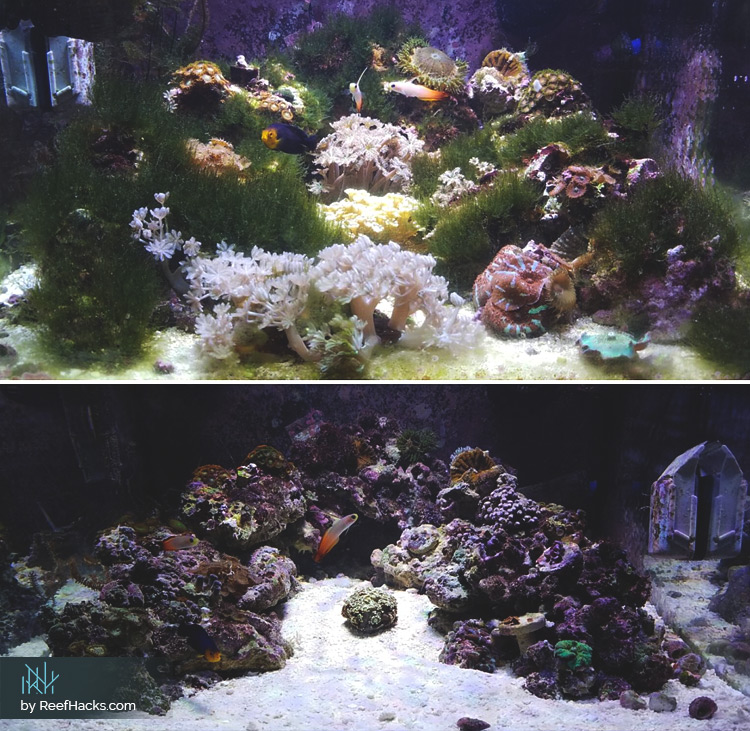
Photography by Alejandro Merizalde ( Reef2Reef user: aimeriza )
Take Charge of Your Reef Tank Health and Vitality.
If you’re battling a Bryopsis bloom, it’s easy to feel overwhelmed, and for good reason. However, you don’t have to combat this invasive organism alone. Whether you’re squaring off for your first battle, or gearing up for another round, we’re here to help!
by Yuliya Ivanova for ReefHacks.

